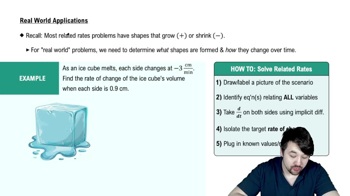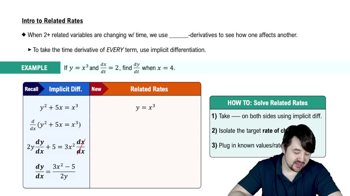Table of contents
- 0. Functions7h 52m
- Introduction to Functions16m
- Piecewise Functions10m
- Properties of Functions9m
- Common Functions1h 8m
- Transformations5m
- Combining Functions27m
- Exponent rules32m
- Exponential Functions28m
- Logarithmic Functions24m
- Properties of Logarithms34m
- Exponential & Logarithmic Equations35m
- Introduction to Trigonometric Functions38m
- Graphs of Trigonometric Functions44m
- Trigonometric Identities47m
- Inverse Trigonometric Functions48m
- 1. Limits and Continuity2h 2m
- 2. Intro to Derivatives1h 33m
- 3. Techniques of Differentiation3h 18m
- 4. Applications of Derivatives2h 38m
- 5. Graphical Applications of Derivatives6h 2m
- 6. Derivatives of Inverse, Exponential, & Logarithmic Functions2h 37m
- 7. Antiderivatives & Indefinite Integrals1h 26m
- 8. Definite Integrals3h 25m
4. Applications of Derivatives
Related Rates
Problem 3.11.7a
Textbook Question
The volume V of a sphere of radius r changes over time t.
a. Find an equation relating dV/dt to dr/dt.
 Verified step by step guidance
Verified step by step guidance1
Recall the formula for the volume of a sphere, which is given by V = (4/3)πr³.
Differentiate both sides of the volume equation with respect to time t using the chain rule to find dV/dt.
Apply the chain rule: dV/dt = dV/dr * dr/dt, where dV/dr is the derivative of the volume with respect to the radius.
Calculate dV/dr by differentiating V = (4/3)πr³, which will give you dV/dr = 4πr².
Substitute dV/dr back into the equation from step 3 to express dV/dt in terms of dr/dt: dV/dt = 4πr² * dr/dt.
Recommended similar problem, with video answer:
 Verified Solution
Verified SolutionThis video solution was recommended by our tutors as helpful for the problem above
Video duration:
3mPlay a video:
Was this helpful?
Related Videos
Related Practice






